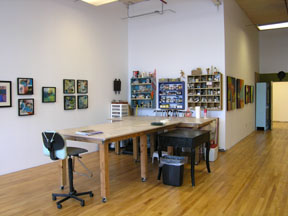In posting my "little somethin-somethin'" about the new Leo Castelli book (Leo and His Circle: The Life of Leo Castelli by Annie Cohen-Solal), I was probably my usual too-hasty self in judging the book's organization. I have to recall how condemnatory I was initially of the wonderful bio of Mark Rothko that I later came to love after spending so much time with it. I rarely think about cultural influences when making judgments that I later come to regret, but today in the NY Times I happened upon a link to a blog called "Bridgers" written by the author of Leo and His Circle, Annie Cohen-Solal.
 |
| Author photo of Annie Cohen-Solal from her blog (and the book cover) |
Cohen-Solal was born in Algeria, is currently Professeur des Universités at the CNRS (Centre National de la Recherche Scientifique)-Paris and Research Fellow at Tisch School of the Arts, New York University. She first came to New York in 1989 as the Cultural Counselor to the French Embassy in the United States, after her Sartre biography, Sartre: A Life, had become an international best seller. She is a 2009 recipient of the Legion of Honor of the French Government.
Not thinking about my cultural background is an American way of viewing the world, but since I am American, it is not something that strikes me as unusual. Cohen-Salal correctly infers that Americans think differently about this than Europeans, and she emphasizes that difference between the American and European worldviews in Leo and His Circle. She contends that history and cultural milieu are important to Europeans in a way that they are not to Americans. In fact, she believes that this difference is what set Leo Castelli apart from other gallerists of his time. She sees him as a "bridger" between Europe and America, who used his European contacts and worldview to see American art in a less parochial way and introduce it to the world stage. It is also why she organized his biography the way that she did by beginning with his family's cultural history - way, way back. Would an American do this? I doubt it, but here is what Cohen-Salal says about it in her blog:
Americans have been notoriously averse to the long view of history and their place in the world. Some would say this is the American way of life: why not a Kardashian reality show as the equivalent of a biographer's five years of effort in researching and writing the biography of a world-changing gallerist? As Americans, we want to cut to the chase, get to the meat of the matter and eliminate all the unnecessary details. In the European view, the long history of Leo Castelli's forebears was a vital part of Cohen-Solal's book, quoting from her blog:
This quote refers also to Castelli's influence in moving the center of the art world from Paris to New York with his promotion of art stars such as Jasper Johns, Robert Rauschenberg, Roy Lichtenstein and James Rosenquist. Americans think this was our due; the French rue this occurrence....."furthermore, as he had a sense of global culture, he overcame the insularity of American art and gave it a legitimacy that it did not have before; he inserted the career of his artists in the continuity of art history and of European art history ("The single artist I never showed but who was always mentioned was MarcelDuchamp", he said), giving it an intercultural scope."
Reading Cohen-Salal's blog has given me her perspective on the book's organization. I now understand why she felt it necessary to research and publish such detail about Castelli's family origins. However, as an American (who doesn't spend much time thinking of herself that way), as an artist and as someone who relishes history and biography, I stand by my initial reaction and still think that the publisher needs to alter at least the American edition of Cohen-Salal's book, not by eliminating the family history but by shifting it to a postscript. I would rather read more about the artists, artist-dealer relationships, how Ivan Karp came to be Castelli's righthand man and what his role was in the Castelli gallery, how the Castelli and Sonnabend Galleries interacted based on the former marriage of Leo and Ileana, and more art-related information such as that. While Tuscan history is interesting in a backgroundish way, it is Leo himself that I want to read about, not his great-great-grandfather, and I say that not in a dismissive or over-Americanizing way, but as someone who buys books about art and important figures in the world of art.
But perhaps Cohen-Salal may come to think about reorganizing the book this way. She concludes in her blog post:
...But there is so much more to it, and that will appear little by little, over the next months, over the course of the reading; I consider the book as an open product, whose text is not fully closed; the questions, the suggestions, the critics enrich it and I am, most of the time, grateful for the new insights that I am offered for the second edition.









1 comment:
Very interesting post, Nancy. I've just ordered the Castelli book for my husband for Christmas. Maybe I'll read the family history, while he skips ahead to the man himself and then we'll compare notes.
For some reason (maybe it's the agent-thing, or maybe the way I was treated in his gallery once years ago), I've held a negative view of Castelli as long as I can remember. It's unfair and not based on much; maybe I'll change my mind after reading about his great grandfather!
Post a Comment